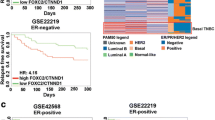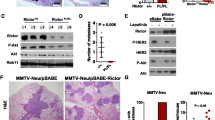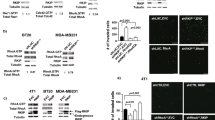Abstract
We aimed to gain a mechanistic understanding of the role of RACK1 in breast carcinoma migration/metastasis. Migration assays were conducted in breast carcinoma cell lines. siRNA targeting RACK1 as well as the Rho kinase inhibitor were also applied. Immunoprecipitation and immunofluorescence were used to study the RACK1/RhoA interaction. GTP-Rho pull-down assays were performed to assess the activation of RhoA. We also conducted immunohistochemistry in 160 breast carcinoma samples. Experiments in vitro showed that RACK1 promotes migration via interaction with RhoA and activation of the RhoA/Rho kinase pathway. Immunohistochemistry in 160 samples revealed that RACK1 is strongly correlated with accepted tumor spread indicators and RhoA (all P < 0.05). Kaplan–Meier survival analysis indicated a correlation between higher RACK1 expression and shorter survival times (P < 0.001). RACK1 is a prognostic factor that promotes breast carcinoma migration/metastasis by interacting with RhoA and activating the RhoA/Rho kinase pathway.




Similar content being viewed by others
References
McPherson K, Steel CM, Dixon JM (1994) ABC of breast diseases. Breast cancer epidemiology, risk factors and genetics. BMJ 309:1003–1006
Tjan-Heijnen VCG, Bult P, de Widt-Levert LM, Ruers TJ, Beex LVAM (2001) Micro-metastases in axillary lymph nodes: an increasing classification and treatment dilemma in breast cancer due to the introduction of the sentinel lymph node procedure. Breast Cancer Res Treat 70:81–88
Cao XX, Xu JD, Xu JW, Liu XL, Cheng YY, Wang WJ, Li QQ, Chen Q, Xu ZD, Liu XP (2009) RACK1 promotes breast carcinoma proliferation and invasion/metastasis in vitro and in vivo. Breast Cancer Res Treat. doi:10.1007/s10549-009-0657-x (Epub ahead of print)
Cao XX, Xu JD, Liu XL, Xu JW, Wang WJ, Li QQ, Chen Q, Xu ZD, Liu XP (2009) RACK1: a superior independent predictor for poor clinical outcome in breast cancer. Int J Cancer. doi:10.1002/ijc.25120 (Epub ahead of print)
Ron D, Chen CH, Caldwell J, Jamieson L, Orr E, Mochly-Rosen D (1994) Cloning of an intracellular receptor for protein kinase C: a homolog of the beta subunit of G proteins. Proc Natl Acad Sci USA 91:839–843
McCahill A, Warwicker J, Bolger GB, Houslay MD, Yarwood SJ (2002) The RACK1 scaffold protein: a dynamic cog in cell response mechanisms. Mol Pharmacol 62:1261–1273
Kubota T, Yokosawa N, Yokota S, Fujii N (2002) Association of mumps virus V protein with RACK1 results in dissociation of STAT-1 from the alpha interferon receptor complex. J Virol 76:12676–12682
Hermanto U, Zong CS, Li W, Wang LH (2002) RACK1, an insulin-like growth factor I (IGF-I) receptor-interacting protein, modulates IGF-I-dependent integrin signaling and promotes cell spreading and contact with extracellular matrix. Mol Cell Biol 22:2345–2365
Wu Di, Asiedu Michael, Wei Qize (2009) MyoGEF regulates the invasion activity of MDA-MB-231 breast cancer cells through activation of RhoA and RhoC. Oncogene 28:2219–2230
Pillé JY, Denoyelle C, Varet J, Bertrand JR, Soria J, Opolon P, Lu H, Pritchard LL, Vannier JP, Malvy C, Soria C, Li H (2005) Anti-RhoA and anti-RhoC siRNAs inhibit the proliferation and invasiveness of MDA-MB-231 breast cancer cells in vitro and in vivo. Mol Ther 11:267–274
Simpson KJ, Dugan AS, Mercurio AM (2004) Functional analysis of the contribution of RhoA and RhoC GTPases to invasive breast carcinoma. Cancer Res 64:8694–8701
van Golen KL, Wu ZF, Qiao XT, Bao LW, Merajver SD (2000) RhoC GTPase, a novel transforming oncogene for human mammary epithelial cells that partially recapitulates the inflammatory breast cancer phenotype. Cancer Res 60:5832–5838
Davies R, Budworth J, Riley J, Snowden R, Gescher A, Gant TW (1996) Regulation of P-glycoprotein 1 and 2 gene expression and protein activity in two MCF7/ADR cell line subclones. Br J Cancer 73:307–315
McShane LM, Altman DG, Sauerbrei W, Taube SE, Gion M, Clark GM (2006) Reporting recommendations for tumor marker prognostic studies (REMARK). Breast Cancer Res Treat 100:229–235
Boettner B, Van Aelst L (2002) The role of Rho GTPases in disease development. Gene 286:155–174
Buensuceso CS, Woodside D, Huff JL, Plopper GE, O’Toole TE (2001) The WD protein Rack1 mediates protein kinase C and integrin-dependent cell migration. J Cell Sci 114:1691–1698
Schechtman D, Mochly-Rosen D (2001) Adaptor proteins in protein kinase C-mediated signal transduction. Oncogene 20:6339–6347
Sklan EH, Podoly E, Soreq H (2006) RACK1 has the nerve to act: structure meets function in the nervous system. Prog Neurobiol 78:117–134
Imai Y, Suzuki Y, Tohyama M, Wanaka A, Takagi T (1994) Cloning and expression of a neural differentiation-associated gene, p205, in the embryonal carcinoma cell line P19 and in the developing mouse. Brain Res Mol Brain Res 24:313–319
Berns H, Humar R, Hengerer B, Kiefer FN, Battegay EJ (2000) RACK1 is up-regulated in angiogenesis and human carcinomas. FASEB J 14:2549–2558
Yoshiji H, Kuriyama S, Ways DK, Yoshii J, Miyamoto Y, Kawata M, Ikenaka Y, Tsujinoue H, Nakatani T, Shibuya M, Fukui H (1999) Protein kinase C lies on the signaling pathway for vascular endothelial growth factor-mediated tumor development and angiogenesis. Cancer Res 59:4413–4418
Bouzahzah B, Albanese C, Ahmed F, Pixley F, Lisanti MP, Segall JD, Condeelis J, Joyce D, Minden A, Der CJ, Chan A, Symons M, Pestell RG (2001) Rho family GTPases regulate mammary epithelium cell growth and metastasis through distinguishable pathways. Mol Med 7:816–830
Denoyelle C, Vasse M, Körner M, Mishal Z, Ganné F, Vannier JP, Soria J, Soria C (2001) Cerivastatin, an inhibitor of HMG-CoA reductase, inhibits the signaling pathways involved in the invasiveness and metastatic properties of highly invasive breast cancer celllines: an in vitro study. Carcinogenesis 22:1139–1148
Bourguignon LY (2001) CD44-mediated oncogenic signaling and cytoskeleton activation during mammary tumor progression. J Mammary Gland Biol Neoplasia 6:287–297
Burridge K, Wennerberg K (2004) Rho and Rac take center stage. Cell 116:167–179
Nobes CD, Hall A (1995) Rho, rac, and cdc42 GTPases regulate the assembly of multimolecular focal complexes associated with actin stress fibers, lamellipodia, and filopodia. Cell 81:53–62
Caron E, Hall A (1998) Identification of two distinct mechanisms of phagocytosis controlled by different Rho GTPases. Science 282:1717–1721
Pertz O, Hodgson L, Klemke RL, Hahn KM (2006) Spatiotemporal dynamics of RhoA activity in migrating cells. Nature 440:1069–1072
Narumiya S, Tanji M, Ishizaki T (2009) Rho signaling, ROCK and mDia1, in transformation, metastasis and invasion. Cancer Metastasis Rev 28:65–76
Amano M, Chihara K, Kimura K, Fukata Y, Nakamura N, Mastuura Y, Kaibuchi K (1997) Formation of actin stress fibers and focal adhesion enhanced by Rho-kinase. Science 275:1308–1311
Ishizaki T, Uehata M, Tamechika I, Keel J, Nonomura K, Maekawa M, Narumiya S (2000) Pharmacological properties of Y-27632, a specific inhibitor of Rho-associated kinase. Mol Pharmacol 57:976–983
Sahai E, Ishizaki T, Narumiya S, Treisman R (1999) Transformation mediated by Rho requires activity of ROCK kinases. Curr Biol 9:136–145
Itoh K, Yoshioka K, Akedo H, Uehata M, Ishizaki T, Narumiya S (1999) An essential part for Rho-associated kinase in the transcellular invasion of tumor cells. Nat Med 5:221–225
Del Re DP, Miyamoto S, Brown JH (2008) Focal adhesion kinase as a RhoA-activable signaling scaffold mediating Akt activation and cardiomyocyte protection. J Biol Chem 283:35622–35629
Nakaya Y, Sukowati EW, Wu Y, Sheng G (2008) RhoA and microtubule dynamics control cell-basement membrane interaction in EMT during gastrulation. Nat Cell Biol 10:765–775
Acknowledgments
The authors acknowledge grant supports received from National Nature Science Foundation of China (No. 30870972 and No. 30872971).
Author information
Authors and Affiliations
Corresponding author
Electronic supplementary material
Below is the link to the electronic supplementary material.
10549_2010_955_MOESM1_ESM.ppt
Immunochemical analysis of clinical cases. Representative immunochemical staining of RACK1 and RhoA from 160 clinical cases is shown. (PPT 11948 kb)
Rights and permissions
About this article
Cite this article
Cao, XX., Xu, JD., Xu, JW. et al. RACK1 promotes breast carcinoma migration/metastasis via activation of the RhoA/Rho kinase pathway. Breast Cancer Res Treat 126, 555–563 (2011). https://doi.org/10.1007/s10549-010-0955-3
Received:
Accepted:
Published:
Issue Date:
DOI: https://doi.org/10.1007/s10549-010-0955-3




